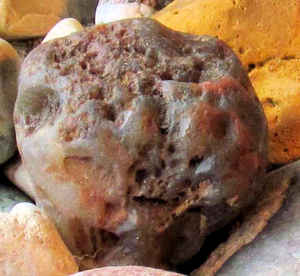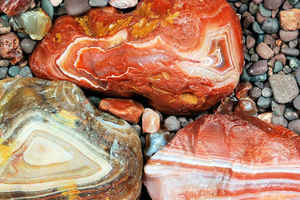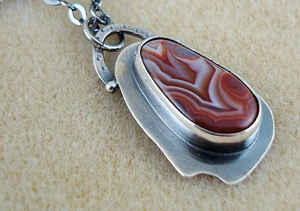Minnesota State Gemstone or Gem
Lake Superior Agate

(SiO2 - Silicon Dioxide)
Adopted in 1969.
In 1969 the Lake Superior agate, SiO2 - Silicon Dioxide, was designated by the Minnesota Legislature as the official state gemstone.
Though some legislators wanted to call the gemstone "The Minnesota Agate," Sen. Mel Hanson, sponsor of the bill, said that rock-hunting clubs in the state preferred keeping the name Lake Superior agate. According to one news account, members of the Senate General Legislation Committee debated for an hour over whether it should be the state rock, stone, or gemstone. Rep. Vernon Hoppe sponsored the companion bill; it was signed into law by Governor Harold Levander.
Lake Superior Agate: Michigan State Gemstone

The Lake Superior agate, was named the official state gemstone in 1969. It is an unusually beautiful quartz stone banded with rich red and orange colors derived from iron ore in the soil. Most agates are about the size of a pea, but some are as big as bowling balls and weigh over 20 pounds. Small agates often are polished to make jewelry; larger "lakers" of up to a pound often are cut into thin slabs to display the colored bands inside. Believed to be the world's oldest agates, over 1 billion years old, these are found throughout the northern US having been spread from the original Lake Superior region by glaciations and are found in northeastern and north central Minnesota. It has generally pale coloring.
The late Mrs. Dahlberg dream was realized, the long-time rock hound and ardent fan of the agate, testified before the state legislative committee considering the bill. She knew how perfect the Lake Superior agate was for the state gemstone.
However, there were other logical candidates. The brazen red Binghamite and blazing yellow silkstone, both iron-rich jaspers found in the Cuyuna iron range area, were logical selections. Thompsonite, the beautiful and popular zeolite mineral found only in Minnesota on an isolated stretch along Lake Superior, was another strong candidate. Pipestone, crafted into peace pipes by Indians in Pipestone, was another possibility.
But a closer look at the history of the Lake Superior agate proves that it was the best choice. The agate reflects many aspects of Minnesota. It was formed during lava eruptions that occurred in our state about a billion years ago. The stone's predominant red color comes from iron, the major industrial mineral in our state. Finally, the widely distributed agate reveals the impact of glacial movement across Minnesota a mere 10,000 to 15,000 years ago.
These unusually beautiful quartz stones are banded with rich red and orange colors derived from iron ore in the soil. Found in northeastern and north central Minnesota, they are often polished to make jewelry.
Geologic History

More than a billion years ago, the North American continent began to split apart into two separate continents. This catastrophic event, spurred by molten rock moving deep within the earth, poured out massive, iron-rich lava flows. These flows now are exposed along the north and south shores of Lake Superior.
The tectonic forces that attempted to pull the continent apart, and which left behind the lava flows, also created the Superior trough. The trough eventually became the basin of Lake Superior and the lava flows became the birthplace of Lake Superior agates.
Water vapor and carbon dioxide became trapped within the solidified flows in the form of millions of bubbles, called gas pockets or vesicles. Later, groundwater carrying ferric iron, quartz, and other dissolved minerals passed through the trapped gas vesicles. These quartz-rich groundwater solutions crystallized into concentric bands of fine-grained quartz called chalcedony.
Over the next billion years, some of these quartz-filled, banded vesicles - agates - were freed by running water and chemical disintegration of the lavas, since these vesicles were now harder than the lava rocks that contained them. The vast majority, however, remained lodged in the lava flows until the next major geologic event that changed them and Minnesota.
About 2 million years ago, the world's climate grew colder signaling the beginning of the Great Ice Age. A lobe of glacial ice, the Superior lobe, moved into Minnesota 10,000 to 15,000 years ago. It followed the agate-filled Superior trough. The glacier picked up surface agates and carried them south. Its crushing action and cycle of freezing and thawing at its base also freed many agates from within the lava flows and transported them, too. The advancing glacier acted like an enormous rock tumbler, abrading, fracturing, and rough-polishing the agates.
Description
Agate, like chalcedony, is a variety of quartz gemstones composed of layers of quartz, sometimes of different colors. Agate usually occurs as rounded nodules or veins in rock such as volcanic lava. The layers of quartz are often concentric. The composition of agate varies greatly, but silica is always predominant, usually with alumina and oxide of iron. Agate comes in most colors. There are several types of agate. Common ones are: blue lace agate, moss agate, tree agate and petrified wood.
The Lake Superior agate differs from other agates found around the world in its rich red, orange, and yellow coloring. This color scheme is caused by the oxidation of iron. Iron leached from rocks provided the pigment that gives the gemstone its beautiful array of color. The concentration of iron and the amount of oxidation determine the color within or between an agate's bands.
The gemstone comes in various sizes. The gas pockets in which the agates formed were primarily small, about the size of a pea. A few Lake Superior agates weigh more than 20 pounds, about the size of a bowling ball. Such giant agates are extremely rare, but no doubt others are yet to be discovered.
The most common type of Lake Superior agate is the fortification agate with its eye-catching banding patterns. Each band, when traced around an exposed pattern or "face," connects with itself like the walls of a fort, hence the name fortification agate.
A common subtype of the fortification agate is the parallel-banded, onyx-fortification or water-level agate. Perfectly straight, parallel bands occur over all or part of these stones. The straight bands were produced by puddles of quartz-rich solutions that crystallized inside the gas pocket under very low fluid pressure. The parallel nature of the bands also indicates the agate's position inside the lava flow.
Probably the most popular Lake Superior agate is also one of the rarest. The highly treasured eye agate has perfectly round bands or "eyes" dotting the surface of the stone.
Source: Minnesota Department of Natural Resources
Minnesota Law
The law designating the Lake Superior agate as the official Minnesota state gemstone is found in the 2008 Minnesota Statutes, Jurisdiction/Civil
Divisions, Chapter 1, Section 1.1475
MINNESOTA STATE GEMSTONE: Lake Superior agate; adopted 1969.
Statutory citation: Minn. Stat. 1.147
History:
1969 Minn. Laws Chap. 404 Sec. 1 (SF132)
1.147 State gemstone.
Subdivision 1. Lake Superior agate. The Lake Superior agate is the official gemstone of the state of Minnesota.
Subd. 2. Photograph. A photograph and a typical specimen of the Lake Superior agate shall be preserved in the office of the secretary of state.
HIST: 1969 c 404 s 1; 1984 c 628 art 1 s 1
Copyright 2002 by the Office of Revisor of Statutes, State of Minnesota.
Minerals, & Gems

Gemstone, Minerals, Rocks







